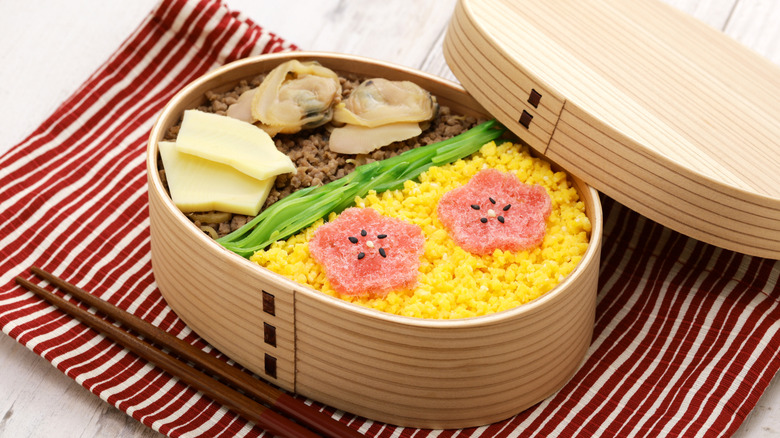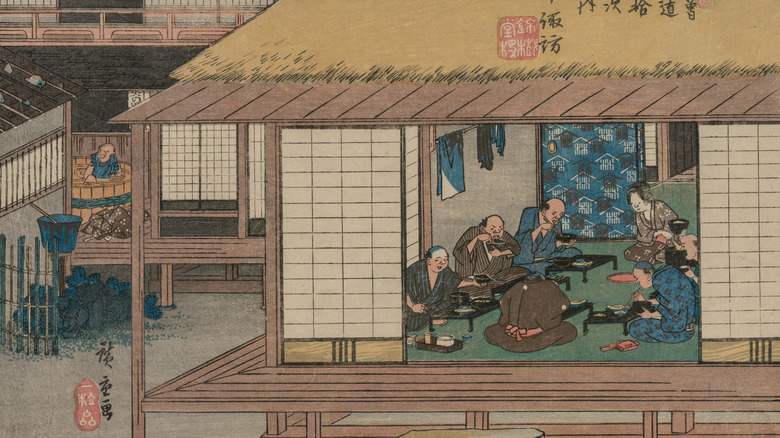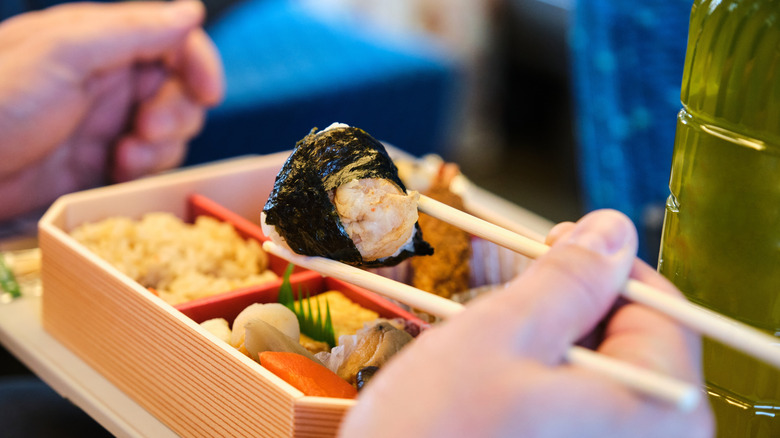The 12th Century Origins Of The Bento Box, One Of Japan's Traditional Lunches
Japan is one of the most culinarily rich countries on Earth, and many of its ancient food traditions live on today. One of the most iconic and resilient of these traditions is the humble bento box — a simple packed lunch representing the confluence of practicality, craftsmanship, aesthetics, and flavor.
This legendary lunch finds its origins in the Kamakura period, which began in 1192 and lasted some 141 years. It was a time of conflict, and the bento is believed to have begun as a way to pack portable meals for warriors. Those early iterations looked very different from what we're now familiar with, consisting of boiled-and-dried rice which could be easily re-boiled on the go. Known as hoshi-ii, meaning "dried meal," they were hardy and, because they were dry, they could be saved for use at any moment, perfect for soldiers both on the road and in the field of combat. The word bento, however, is actually Chinese — the slang word biàndāng (meaning "convenience") made its way over to Japan sometime around the invention of hoshi-ii, and the name stuck.
How the bento box evolved over time
By the 16th century, bento had evolved significantly. The Edo period brought with it an era of peace and prosperity, and as such the bento became not only the food of soldiers, but of local travelers going on pilgrimages (the only way for most people to explore Japan at the time). As it grew to be a more ubiquitous part of Japanese culture, the bento began to reflect the aesthetic sensibilities of the era. This period gave rise to beautifully crafted, ornate wooden bento boxes that were as much about the box itself as the food within. That, of course, changed too. It became popular to wear bento boxes around the waist containing onigiri (rice balls), known as koshi-bento. Slightly more substantial boxes also appeared, called makunouchi consisting of rice, fish or meat, vegetables and umeboshi (pickled plums). These were commonly sold during the intervals of kabuki performances (traditional Japanese theatre), and can be seen as the genesis of what we know as the modern bento box — and makunouchi are still sold today.
As these meals became more elaborate, the principle of ichi-juu-san-sai came about. This means, literally, "one soup, three sides" and established the now traditional composition of a bento box. Though this would continue to evolve, that tenet of balance remains crucial to the identity of the bento.
The modern bento box
The advent of the railway brought the bento box squarely into the modern era. In 1885, Utsunomiya station (in the eponymous city) saw the introduction of ekiben — a portmanteau of eki (meaning "train station") and bento. The original ekiben were actually closer to the earlier first bento, consisting of the traditional Japanese meal of onigiri which could be filled with just about anything. These train station bentos soon spread across Japan and locals began customizing their ekiben to reflect local culinary specialties, from pork belly onigiri to onigiri stuffed with pickled radishes.
Today, bento boxes have diversified even more. As well as the ekiben still sold in Japanese train stations, konbini (convenience stores) also sell bento boxes that you can pick up cheap for a delicious, filling lunch on the go, and are popular among office workers and commuters. Oekakiben emphasize the aesthetics, providing a canvas for cooks to use the ingredients to create elaborate images of popular locations, and kyaraben use the same method to make pictures of characters. Koraku are the Japanese equivalent of a picnic hamper, made for sharing. The richly adorned boxes of the Edo period have fallen a little out of fashion, with the modern bento instead being most often made of metal, plastic, or glass, emphasizing durability and convenience — perfect for an everyday lunchbox. The bento has come far from its humble 12th-century origins, but its essence remains stronger than ever.



